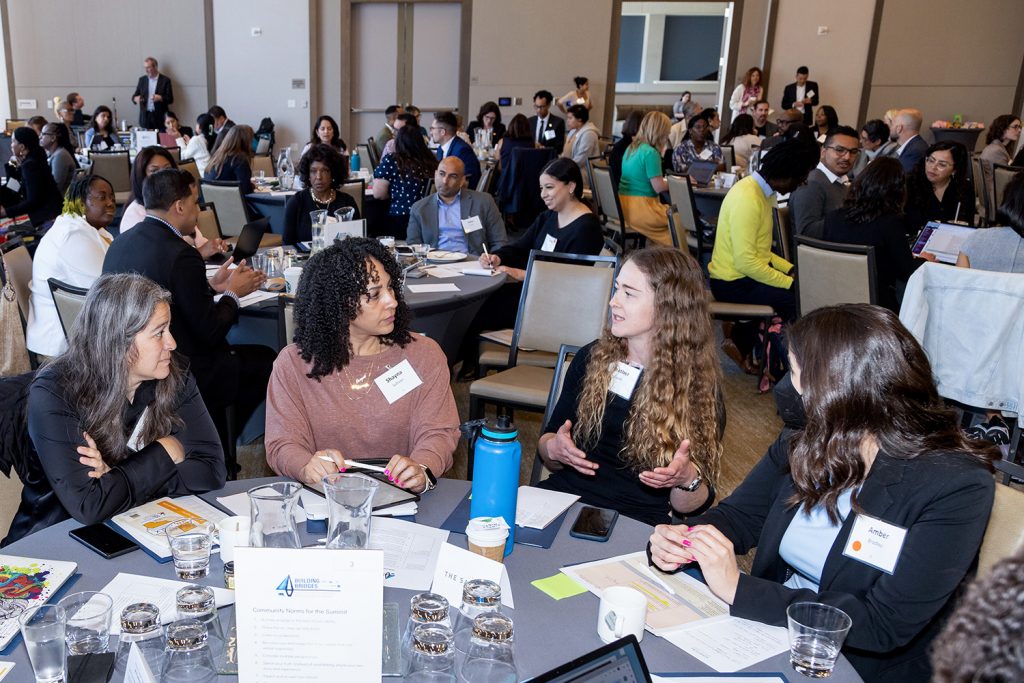
Educators, policymakers, K-12 leaders, higher education leaders, non-profit leaders, researchers, and advocates from across California recently gathered to develop a shared understanding of the root causes of why educators of color and multilingual educators enter, stay, and leave the profession and co-create a road map for building and supporting a diverse and sustainable teacher workforce in California.
On April 10, in Sacramento, the summit, “#CABuildingBridges: Setting the Vision for Sustaining BIPOC Educators in California,” was designed by classroom teachers and led by a coalition of organizations including Latinos for Education, One Million Teachers of Color Campaign, Teach Plus, The Education Trust-West, TNTP, and UCLA’s Center for the Transformation of Schools.
“Understanding how the state can support and sustain diverse educators is more important than ever. With the challenges facing California students and educators today, they are looking to state and local leaders to help set them up for success,” said Sarah Lillis, executive director of Teach Plus California.
“We hope that the Building Bridges summit leads to a galvanizing vision for a robust infrastructure that not only supports teachers’ development in meeting the academic and social emotional needs of their students, but also creates mechanisms that value their contributions as professionals and sustain them as individuals.”
Related Links:
https://lasentinel.net/extra-yard-for-teachers-summit-celebrates-local-educators.html
https://lasentinel.net/dorsey-teacher-creates-lessons-to-teach-black-history.html
The #CABuildingBridges summit kicked off with a welcome and keynote by Secretary of State Shirley Weber. In subsequent sessions, attendees did a deep-dive into a range of issues connected to teacher recruitment and retention, from understanding the current state of the teaching profession to gauging the state’s role in supporting TK-12 students to creating the conditions and infrastructure to support and sustain educators of color and multilingual educators in California’s classrooms. Attendees learned directly from teachers and students of color about their experiences in the K-12 system, and how these experiences affect their social and emotional well-being and academic success.
“Our ultimate goal must be to ensure that every student has an exceptional teacher in the classroom to guide their learning, and that these teachers together reflect the diversity of our state,” said Dr. Manuel Rustin, a high school social science teacher at John Muir High School Early College Magnet in Pasadena, California, Teach Plus California Policy Fellow, and summit panelist.

“Although an abundance of existing state policy aims at making sure our classroom teachers are well-prepared, more needs to be done to address our goal of diversity and promote a robust, sustainable teaching force that mirrors the many languages, cultures, and backgrounds of our students.”
Dr. Rustin also reflected on his school year and the love he received from his students. “On the last day of the school year, Steve, one of several Black sophomores in my class, wrote me a farewell message. It read: ‘U probably been one of the best teachers I’ve had & plus U are an African American graduate from Harvard. Now I have bragging rights to say I have been fully taught by an African American college graduate from Harvard.’
“I had not considered that a student might brag about having me as their teacher, but Steve wrote what many Black kids across the nation are thinking when they have a Black teacher directing their learning with love, talent, and precision. Steve recognized that he had the rare privilege of having one,” he said.
“However, having teachers of color in the classroom isn’t just about students of color. For Gary, a White student in my class, having a Black teacher meant bringing balance to his developing views of race in America. Our hours of conversation during lunch breaks and between class periods offered him a way to interrupt the traditional anti-Black narratives presented across our media and political landscapes,” noted Rustin.
“I’ve taught hundreds of students like Steve and Gary. I’m still a rarity though, often hearing students say I’m the only Black male teacher they’ve had. Generations of California’s kids are still awaiting their chance at having a teacher of color.
“Among them, also, are an untold number of teachers-in-waiting, if only we’re serious enough to welcome them into the profession. Let’s make sure we do everything we can to support a sustainable, ethno-racially and linguistically diverse educator workforce.”
For more information on future events, and resources for educators visit teachplus.org!







